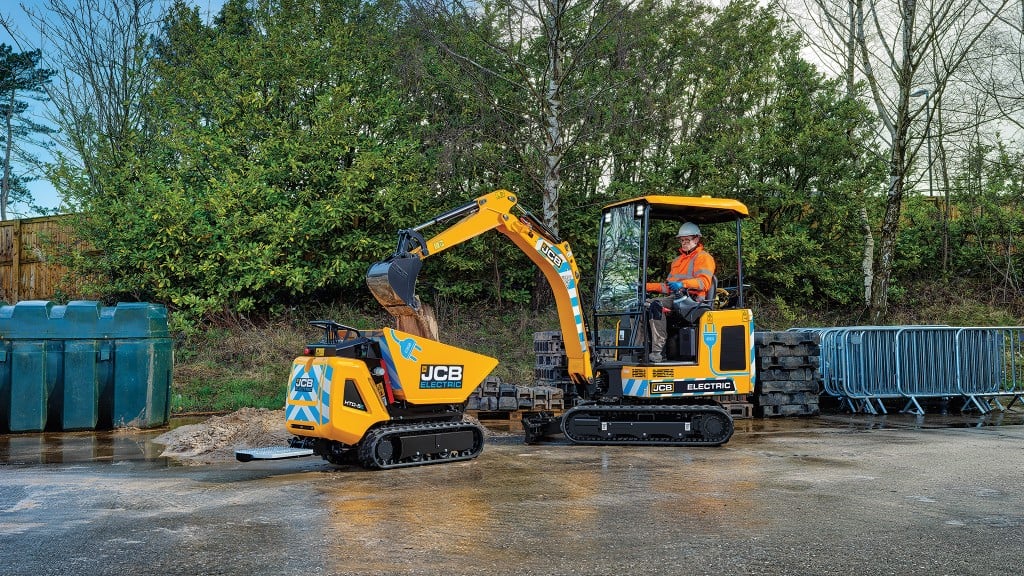Why compact machines are electric’s first real win
Battery-electric equipment is tailored to match the needs of real-world applications
- By
- Lee Tice – product manager at JCB

While big machines chase future fuels like hydrogen and hybrid systems, compact equipment is quietly getting it done with battery power.
JCB
Battery-electric machines are showing up everywhere in construction headlines, but there’s one category that’s already proving its worth where it counts on the job site. While big machines chase future fuels like hydrogen and hybrid systems, compact equipment is quietly getting it done with battery power. This isn’t about what might work someday. This is about what’s already working today.
Electric’s first big win in construction
Electric technology isn’t new, but finding the right fit for it in construction is. Compact machines like mini excavators, electric dumpers, and telehandlers have hit the sweet spot where battery tech meets real-world demands. These machines don’t need oversized battery packs or complicated charging solutions. They’re light, efficient, and built for jobs that match the strengths of electric power.
Why does this matter? Because construction is under increasing pressure to lower emissions, reduce noise, and work within tighter site regulations — especially in urban and residential areas. Compact electric machines meet these challenges without asking crews to change how they work.
Purpose-built for how crews actually work
Unlike heavy machines that stay put and grind through massive workloads, compact equipment moves with the rhythm of modern job sites — short bursts of activity, frequent transport, and tight workspaces. These are not machines being used to dig mile-long trenches, they tackle specific tasks, get loaded back on the trailer, and head to the next job. Electric power fits that kind of routine perfectly.
Manufacturers have tapped into this reality using telematics and real-time usage data collected from connected fleets across North America and beyond. That data reveals how long machines are active, how often they’re moved, and what types of work they’re actually doing.
Rather than building to theoretical extremes, manufacturers are designing for what’s typical. They’re engineering battery capacity to support a full day’s work based on duty cycles without overburdening machines with excess weight or complexity. Layouts are optimized for the electric drivetrain, not adapted from diesel platforms. That intentional design results in machines that are not only efficient but easier to operate and maintain.
Rather than building to theoretical extremes, manufacturers are designing compact battery-electric equipment for what’s typical in its application.
JCB
Expanded operations, greater opportunities
What really sets electric compact equipment apart is how it expands a contractor’s reach. These machines open up new job site possibilities by eliminating some of the biggest limitations tied to diesel: noise, fumes, and operating hour restrictions.
With near-silent operation and zero emissions, crews can work in noise-sensitive zones like residential neighborhoods or around hospitals. Jobs can start earlier, run later, and be done indoors without the need for ventilation. That level of flexibility helps contractors secure more bids, meet stricter project specs, and reduce downtime waiting for access windows.
In practice, that could mean a crew pouring a foundation next to a school during class hours or finishing landscaping in a park over a weekend without disturbing the public. Electric compact machines make these types of jobs not just possible, but practical.
And it’s not limited to traditional construction. Sectors like food production, event venues, and equestrian facilities are embracing electric machines for their clean, quiet, and low-disruption operation. Whether it’s preparing a show arena, working inside a warehouse, or supporting maintenance at a processing plant, compact electric equipment extends its value well beyond the standard job site.
Charging that makes sense in the field
Charging infrastructure has long been seen as a barrier to electric adoption, but that’s changing fast, especially in the compact space. Manufacturers are standardizing inputs and cable types across product lines, making it possible to run multiple machines on a single charger. No guesswork, no multiple systems — just plug and go.
These machines are designed to recharge overnight, keeping job site downtime to a minimum. And because they’re built from the ground up for electric, component placement and access are optimized for ease of maintenance and service. They are not crammed in wherever space was available.
The proof point for the future
There’s a lot of talk about the future of construction equipment, but compact electric machines are already proving what’s possible. They’ve become a practical entry point into alternative energy without requiring a complete rethink of operations.
They’re not a compromise. They’re a solution backed by job-tested performance, operator familiarity, and growing demand in sectors that need clean, quiet, capable machines.
For anyone still on the fence about electric construction equipment, compact machines make the strongest case yet: it’s not about if, it’s about where to start — and this is it.





![Swollen Galaxy Ring battery gets stuck on finger, leads to hospital visit [Gallery]](https://zolairenergy.com/wp-content/uploads/2025/09/14615-swollen-galaxy-ring-battery-gets-stuck-on-finger-leads-to-hospital-visit-gallery-80x80.jpg)